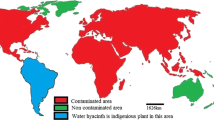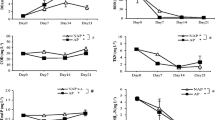Abstract
Tests were conducted under greenhouse conditions to evaluate the ability of Eichhornia crassipes (Pontederiaceae) and Sphagnum quinquefarium (Sphagnaceae) to ameliorate acid mine water discharged from coal operations. In addition, the survivorship and growth rate ofE. crassipes (water-hyacinth), cultured in toxic acid mine water, were determined. The results of both short-and long-term studies indicated thatE. crassipes readily reduced levels of heavy metals in acid mine water while the plants exhibited few signs of toxicity. Patterns of reduction of pollutants, for bothE. crassipes andS. quinquefarium indicated that treatment efficiency could be improved by the periodic harvesting of plants. It is suggested that the ease with which water-hyacinths can be introduced into wetlands and harvested cannot be economically duplicated with other plants currently in use in treating acid mine water.
Similar content being viewed by others
Literature Cited
APHA (American Public Health Association). 1975. Standard methods for the examination of water and wastewater. 14th ed. APHA, Washington, DC.
Bastian, R. K., and R. C. Reed. 1979. Aquaculture systems for wastewater treatments: seminar proceedings and engineering assessment. U.S. Environmental Protection Agency 430/9-80-006.
Chan, E., T. A. Bursztynsk, W. Hantzsche, and Y. J. Litwin. 1982. The use of wetlands for water pollution control. U.S. Environmental Protection Agency 600/2-82-086.
Chigbo, F. E., R. W. Smith, and F. L. Shore. 1982. Uptake of arsenic, cadmium, lead, and mercury from polluted waters by the water hyacinthEichhornia crassipes. Environ. Pollut. Ser. A. 0143-1471/82/0027-0031.
Deason, T. R., and H. C. Bold. 1960. Phycological studies I. Exploratory studies of Texas soil algae. Univ. Texas Publ. 6022.
Dinges, R. 1976. Water hyacinth culture for wastewater treatment. Texas Dept. Health, Austin.
Englemann, M. H., and T. E. Weaks. 1985. An analysis of the effects of strip-mining disturbance on bryophyte species diversity. Bryologist 88:344–349.
Ghin, Y. B. 1979. A preliminary study on the use of water hyacinth in the removal of heavy metals and BOD from industrial wastewaters. Presented at the Conference on Chemical Research in Malaysia, Kuala Lumpur, Malaysia.
Girts, M. A., and R. L. P. Kleinmann. 1986. Constructing wetlands for treatment of mine water: successes and failures. Pages 67-73in Symposium on surface mining, hydrology, sedimentology and reclamation. Univ. Kentucky, Lexington.
Gupta, G. C. 1980. Use of water hyacinths in wastewater treatment. J. Environ. Health 43:80–82.
Hammer, D. E., and R. H. Kadlec. 1983. Design principles for wetland treatment systems. U.S. Environmental Protection Agency 600/S2-83-026.
McDonald, R. C., and B. C. Wolverton. 1980. Comparative study of wastewater lagoon with and without water hyacinth. Econ. Bot. 34:101–110.
Sculthorpe, C. D. 1967. The biology of aquatic vascular plants. Ballantyne and Co. Ltd., London.
Snyder, C., and E. C. Aharrah. 1984. The influence of theTypha community on mine drainage. Pages 149-153in D. H. Graves, ed., Proceedings of 1984 symposium on surface mining, hydrology, sedimentology, and reclamation. University of Kentucky, Lexington.
Titus, J. E., and D. J. Wagner. 1984. Carbon balance for twoSphagnum mosses: Water balance resolves a physiological paradox. Ecology 65(6): 1765–1774.
Ueki, K., M. Ito, and Y. Oki. 1975. Water hyacinth and its habitats in Japan. Proceedings of the 5th Asian—Pacific Weed Science Society Conference, Tokyo.
Villamil, J., R. Clements, M. Block, P. Weil, G. Garcia, W. Lao, L. Rosa, and F. Santos. 1979. Water hyacinths for the clarification of wastewaters and the production of energy. Report—Center for Energy and Environment Research. Univ. Puerto Rico, San Juan.
Vitt, D. H., and N. G. Slack. 1975. An analysis of the vegetation ofSphagnum-dominated kettlehole bogs in relation to environmental gradients. Canad. J. Bot. 53(4):332–359.
Wieder, R. K., and G. E. Lang. 1982. Modification of acid mine drainage in a freshwater wetland. Pages 43-53in Symposium of wetlands of the unglaciated Appalachian Region, May 26–28. West Virginia Univ., Morgantown.
Wolverton, B. C. 1975. Water hyacinths and alligator weeds for final filtration of sewage. NASA Techn. Memorandum TM-X-72724.
—, and R. C. McDonald. 1979. Upgrading facultative wastewater lagoons with vascular aquatic plants. J. Water Pollut. Control Fed. 51:305–313.
Wooten, J. W., and J. D. Dodd. 1976. Growth of water hyacinths in treated sewage effluent. Econ. Bot. 30:29–37.
Author information
Authors and Affiliations
Rights and permissions
About this article
Cite this article
Falbo, M.B., Weaks, T.E. A Comparison ofEichhornia crassipes (Pontederiaceae) andSphagnum quinquefarium (Sphagnaceae) in treatment of acid mine water. Econ Bot 44, 40–49 (1990). https://doi.org/10.1007/BF02861065
Received:
Accepted:
Published:
Issue Date:
DOI: https://doi.org/10.1007/BF02861065




